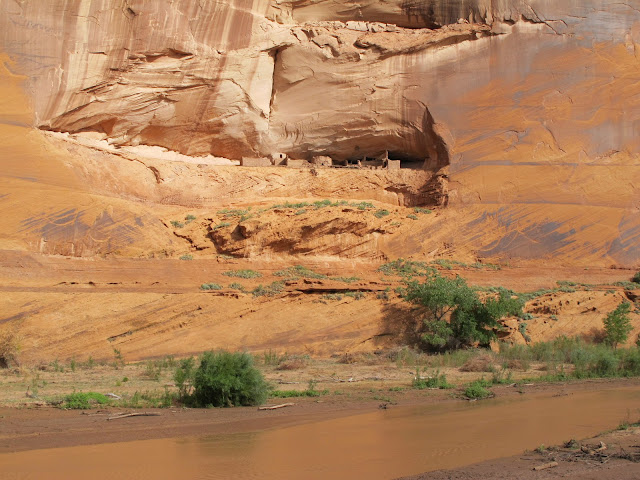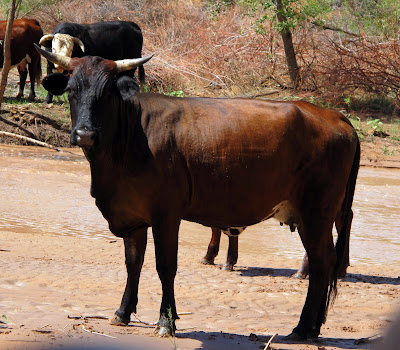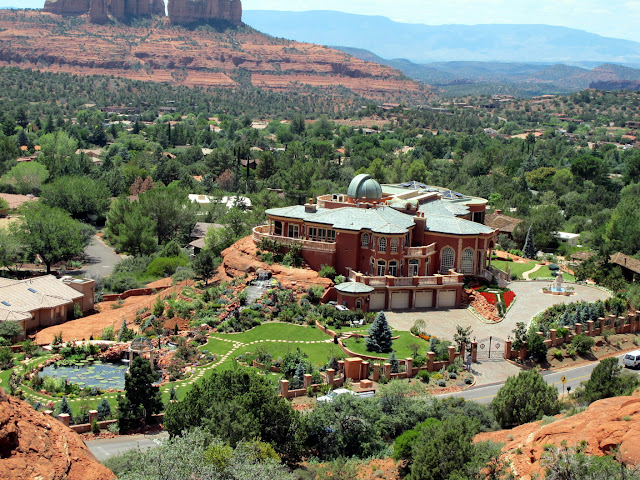Phoenix, AZ
Our motel in Sedona was very comfortable. In the morning, we returned to the main part of Sedona where Black Canyon ended. The Frenchies did about an hour and a half of shopping in the upscale boutiques, galleries and gift shops. We then took a drive through the surrounding area and visited the Church of the Rocks.
We started to really feel the heat now that we were off the high plateaus of Utah and Arizona. It was 105 degrees F late in the afternoon as we drove through the everlasting suburbs of Phoenix.
We drove straight to Phoenix for our next overnight stop. I do not know too much about Phoenix and any tourist highlights of the city, so I was at a loss to do much guiding of the family to any attractions of that fair city. I did not take any photographs in Phoenix.
Our hotel was right in the downtown area. This was the overnight location I was most concerned with – would noise and crime be a problem at an inexpensive motel located in a city core? As it turned out, the motel was clean, well maintained and quite secure.
We rested a bit and then drove right into the downtown center to do a bit of touring by auto. We found a Sports Pub and had our dinner amidst the loud cacophony of half a dozen TV sets all turned to different games on various sports channels.
In the morning, we drove West via Interstate 40 towards California and our next night stop in Palm Springs California. It was already very hot and remained that way all day. A major traffic accident nearly closed the freeway. We took off to drive on the frontage road and luckily found a Waffle House restaurant within a few miles where we stopped for an excellent breakfast.
The Waffle House restaurants are a chain of small, inexpensive, 24 hour, 7 days a week café eateries that feature waffles and other breakfast fare. Foods for the other meals of the day are listed on the menu as well. I think the Frenchies enjoyed the food as much as I did.
We drove rapidly to the border of California, crossing the Colorado River for the last time at Blythe, Ca. Once again we found a super market to buy beverages and delicatessen sandwiches for our lunch.
By the way, no one in the French Family drinks wine, they are happy with bottled water and soft drinks. We were directed to a small park on the river by a store clerk where we had our lunch in the shade. It was extremely hot!
By the way, no one in the French Family drinks wine, they are happy with bottled water and soft drinks. We were directed to a small park on the river by a store clerk where we had our lunch in the shade. It was extremely hot!
Palm Springs
We arrived in Palm Springs by the mid afternoon. Our motel for the night was quite upscale, well decorated and very comfortable.
Summer is the low season for Palm Springs because of the extreme heat caused by its location at the edge of the Mojave Desert tucked up at the bottom of the Eastern side of the San Jacinto Mountain Range.
We spent several hours in the pool at the motel waiting for the sun to go down before heading out to dinner and to explore the small city center and make a decision about where to have dinner.
We spent several hours in the pool at the motel waiting for the sun to go down before heading out to dinner and to explore the small city center and make a decision about where to have dinner.
 |
| Pool at Best Western Las Brises - Palm Spings, Ca |
Once again most of the people staying at the motel were families from Europe touring the Western United States – Germans, Italians, French and a few Eastern Europeans.
We had dinner at a small café that featured hamburgers. I took a photo of Nicholas with the “waitress” figure at the entrance of the restaurant.
 |
| Nicholas in Palm Springs, Ca |
I was surprised at how small the city center of Palm Springs is. In my memory picture of Palm Springs, the city has block after block of very swank art galleries, restaurants and gift shops. It is all that, but only a few blocks – so much for my memory!
The next morning, we had breakfast at the motel before going to the Palm Springs Aerial Tram to ride to the top of the San Jacinto Mountains above Palm Springs. The tram goes up the mountainside through Taquitz Canyon. The gondola car on the tram slowly turns so that everyone can get a 360 degree view of the desert and canyon as the gondola ascends the cable.
 |
| Going up! Palm Springs Tram |
There is a museum, clean bathrooms, a large cafeteria and fine dining room at the tram station on top. Daniel, the father of the family, is quite a hiker, so he immediately set off on a two hour hike into the forest of large pines and cedar trees there on top of the ridge.
 |
| Terrace and cafe at the top - Palm Springs Tram - Palm Springs below |
I was a bit worried about Daniel getting lost – as many hikers who wander too far into the forest do every year. But, he returned in time for a late lunch with us there on the terrace overlook.
The cooler air high up on the mountain was very welcome relief from the furnace like temperatures at the bottom tram station. We descended in the tram and then down the very steep road from the tram station to the highway below.
 |
| Gondola Leaving Upper Tram Station - Palm Springs Tram |
 |
| Going Down - Lower Tram Station Below - Palm Springs |
The constant heavy braking required on the steep road from the tram station to the highway caused our brakes to overheat. I think this was the beginning of a brake problem that increased during the next week and a half. The brakes would heat up and cause heavy vibrations that got progressively more intense on the many mountain roads we encountered farther down the road.
After the trip up the mountain by the tram, we drove to Riverside, Ca. for the weekend (Friday to Monday morning) to visit with my family members who live in this area.
Family Interlude, Riverside, Ca.
We all met at my daughter in law, Deanna’s, home and from there went out for steaks at an inexpensive steakhouse we patronize in the Fontana, Ca. area.
The Frenchies had met Deanna’s family during their first visit to the United States in summer of 2008. They all went to Disneyland with the Deanna and her girls that year.
The Frenchies had met Deanna’s family during their first visit to the United States in summer of 2008. They all went to Disneyland with the Deanna and her girls that year.
 |
| Me and my family (including granddaughter's boyfriends) and the Frenchies |
This year they met my grandson, Josh, his new baby, Nicaise and Nichole, the baby’s mother.
 |
| My Great Grandson, Nicaise & Katy |
I had permission from the hotel, Courtyard by Marriott located by University of California – Riverside, to have a swim party for all my relatives in the area at the hotel pool. We had the swim party the next day, Saturday. The Frenchies met my other set of grandchildren and their mother, Kathleen, at the party. I believe everyone had a good time.
 |
| Hotel Swim Party - L, Deanna, Katy, Mathieu, Nicholas, Daniel, Kathleen, Kristina |
Later in the day, we celebrated Deanna's birthday.
 |
| Deanna's Birthday Cake - From Left Danielle, Kathleen, Deanna, Daniel, Nicholas, Mathieu, Ashley |
Sunday, The Frenchies and I and two of my granddaughters went to see an Angel’s baseball game at the Angel’s Stadium in Anaheim. They had seen a baseball game on their first trip to the US. The Frenchies all bought souvenir baseball caps and seemed to enjoy the game.
 |
| 2008 Frenchies at Angel Stadium |
 |
| 2010 - Mathieu, Nicholas, Savannah, Daniel, Katy, Daniel & Mikinzie |
We had a pleasant surprise at the hotel check out. They had booked us at a reduced weekend rate for Friday and Saturday nights for our large and pleasant rooms. We drove down to San Diego for our next 3 day stop.
San Diego, Ca.
I had probably overloaded the itinerary (at their request with an enormous list of places and things to see and do) on their first trip - not really giving the family a chance to stop and rest. I tried to avoid that mistake on this trip. They wanted to visit the San Diego Zoo and Sea World … and, I knew they liked the beach, so I did quite a bit of research to find a hotel or motel that would be inexpensive, clean, and comfortable yet on or very near the beach. I found the Mission Bay Motel in Pacific Beach, Ca. which seemed to fill those requirements.
The motel is located across the street from the beach at Pacific Beach, a long well maintained, beautiful beach. It was inexpensive for a motel located so close to the ocean even if a bit old in style and lacking in amenities. There was a very nice restaurant across the street where we had our breakfast each of the 3 mornings we were in San Diego.
 |
Pacific Beach, California - Panoramic view
The Frenchies and I went to Old Town San Diego just as it was getting dark the first of our 3 nights in San Diego. They spent the next day at the San Diego Zoo, a lot of time on the beach and window shopping nearby. I did not go with them to the zoo as I have seen it several times – I did a lot of reading and did all our laundry again.
 |
| Church - Old Town, San Diego, Ca. |
 |
| Gift Shop - Old Town, San Diego, Ca. |
 |
| Neon Sign - Pacific Beach Restaurant, San Diego, Ca. |
 |
| Mexican Handicrafts - Old Town, San Diego. Ca/ |
 |
| Nicholas & Friend, Old Town, San Diego, Ca. |
They decided to cross Sea World off their list of places to visit due to the high cost of entry.
Thanks for taking the time to look at the photos and read the blog. Your comments are welcome.
Next time – 2 California Missions, Hollywood, Magic Mountain, Kings Canyon and Sequoia National Parks.































